During one day, 16 sunrises and as many sunsets can be observed on the International Space Station. The question arises: when should astronauts go to bed and wake up on the station? To answer this question, we need to understand why and how we sleep.
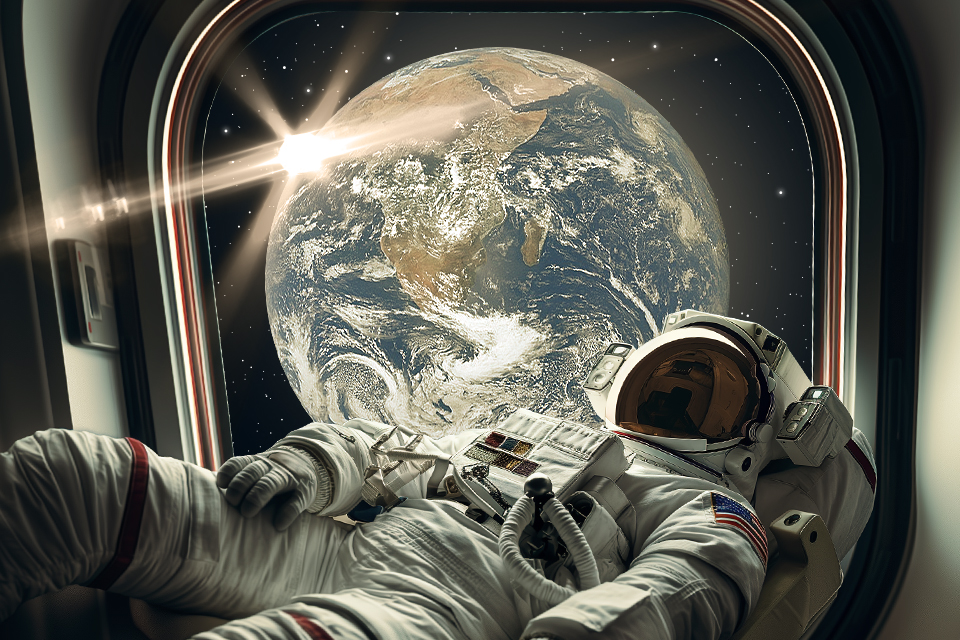
What is sleep?
On March 15, the world celebrates International Sleep Day. Staying in a calm, unconscious state is a biological need for most animals on Earth, and humans are no exception. This process is so natural that we don’t even think about the fact that we may find ourselves in a situation where the environment itself will create significant problems for us.
However, there is a place where sleep is consistently problematic. The International Space Station (ISS) orbits our planet in about 90 minutes. This means that it is dark on board 16 times a day, which can rightly be called night.
The question arises: how do the astronauts on board the ISS need to sleep? 16 times for 45 minutes, or the same way they did on Earth, or whenever they want? To understand this, we need to delve into biology. In fact, sleep is a rather complicated process. It has several phases, during which different parts of the brain are activated. At the same time, the functions of sleep and its course can vary greatly between different living organisms. Therefore, in the future, it is worth talking about this phenomenon in humans.
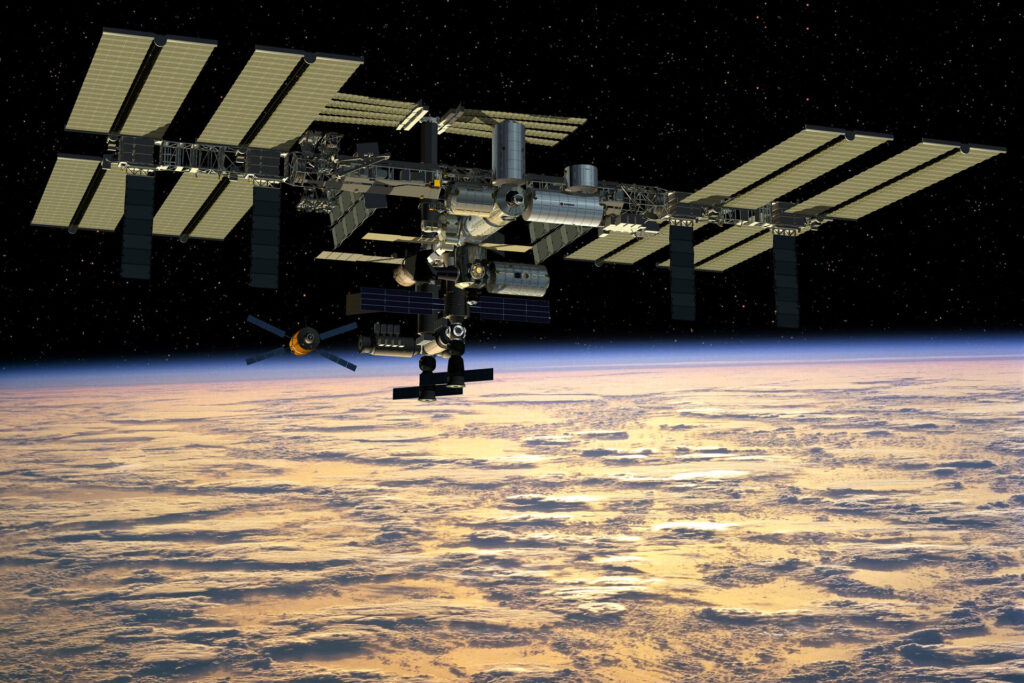
Humans are one of the relatively few creatures on Earth that sleeps only once a day. This feature was given to us by our ancestors, the daytime primates. For them, nighttime activity was not only meaningless but also dangerous, so they used this time to rest.
In principle, we can fall asleep at any time when our body can fully relax, for example, when we are very tired. However, it is at night that it is easier for us to do this than during the day, and it is at this time that most people rest.
Scientists have established that this situation is biological in nature. The hormone melatonin is responsible for drowsiness in the animal kingdom. This chemical is produced by the pineal gland and is able to bind to special receptors in our brain and suppress its activity, creating conditions for a restful rest.
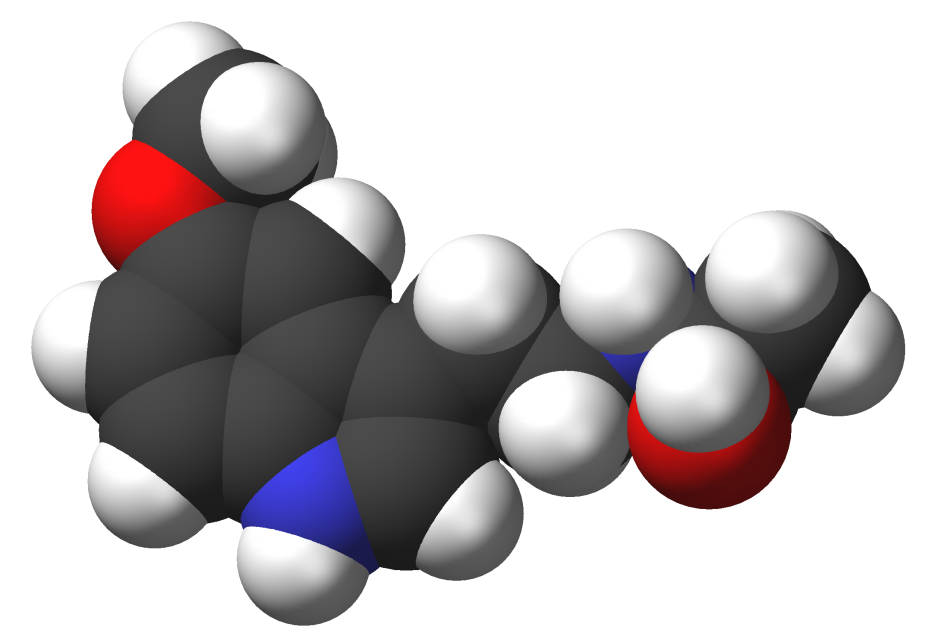
Circadian rhythms
But why is melatonin produced in the evening and at night? The answer to this question is usually summed up in the words “circadian rhythms.” This is the name given to fluctuations in the level of hormones in the body that repeat every day and set the rhythm of biochemical activity of organs.
It should be noted that the sleep-wake cycle is only one of several circadian rhythms. Others may be responsible, for example, for the fact that we feel hungry at certain hours and know that it is time for dinner.
Not only humans have circadian rhythms. In fact, the idea that the activity of biological objects during the day is determined by some kind of “internal clock” was originally proposed for plants. And in 1984, during experiments with the fungus Neurospora gusta, it was proved that circadian rhythms do exist and are endogenous in nature, that is, they do not directly depend on either light or the Earth’s rotation.
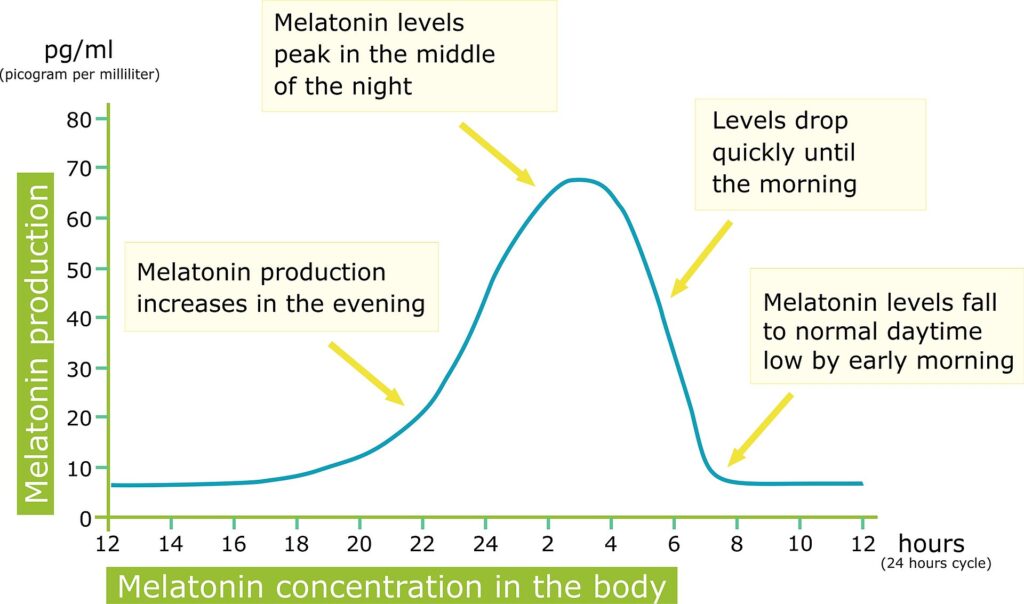
In the same year, Jeffrey Hall and Michael Rosbish, working in Boston, were able to determine that the Per gene, previously discovered in Drosophila flies, encodes the PER protein. The latter turned out to be universal for all living things and had interesting features. Using a fairly simple mechanism, it could stimulate its own production. This substance accumulated in the body at night and decomposed throughout the day, only to start producing again in the evening.
In different organisms, PER interacts with different proteins, creating a large number of combinations of what can happen. But in general, it is a biochemical clock built directly into living cells. By itself, it does not need additional “winding up” from external factors and can relatively confidently “keep the rhythm” regardless of what is happening around it, but it is still possible to influence it if necessary.
PER protein itself does not affect the overall activity of the brain. However, it is produced in the pituitary gland, is distributed throughout the human body, and acts on all the glands where other hormones are produced. And it is even easier for it to affect the pineal gland, which is located nearby inside the human brain, than anything else. It is the clock that our body checks to determine when it needs to produce melatonin to fall asleep.
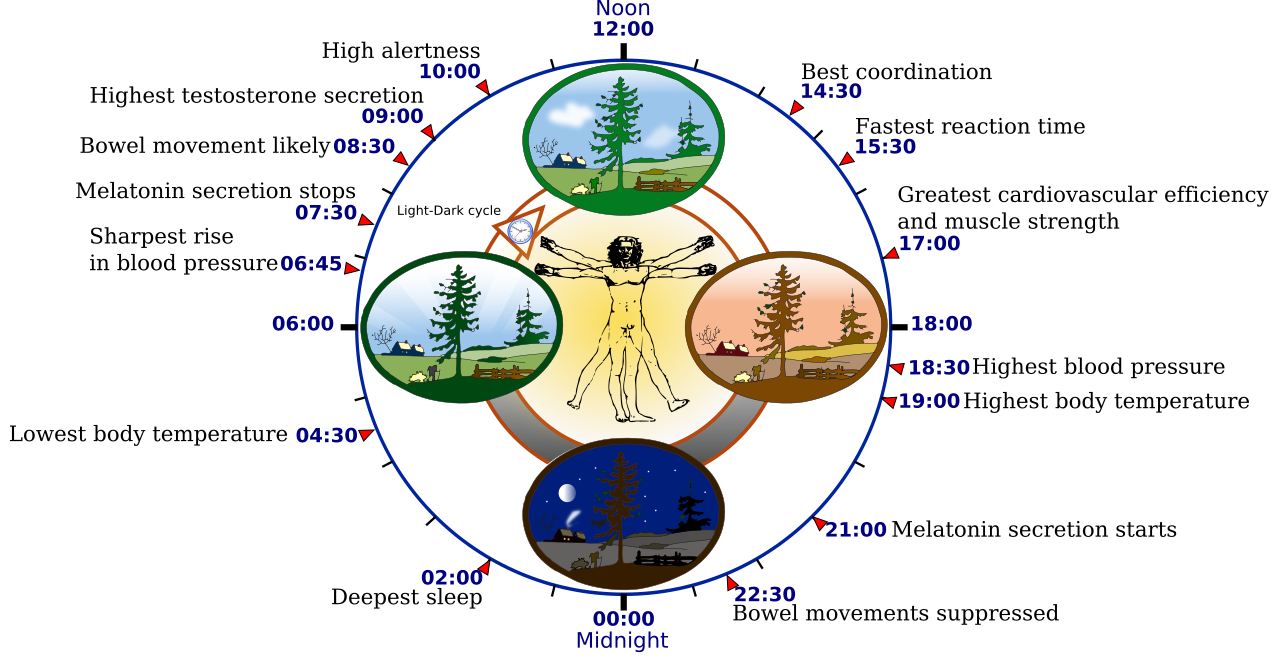
Is it possible to “turn back the hands” on a biological clock?
Sometimes you hear that in the absence of changes in natural light, the human sleep-wake cycle is 25 hours. This figure was established in one of the first experiments to study circadian rhythms. This work has been used in many publications.
The 25-hour human circadian rhythm is very popular with supporters of the theory that humanity did not evolve on Earth but was brought by aliens from some other planet. How else to explain the fact that it does not coincide with the usual 24-hour day?
In fact, the explanation is much simpler. In the first experiment, participants had the opportunity to determine when to switch off the lights in the evening. Using this option, they left the light on longer and thus slightly extended their sleep-wake cycle.
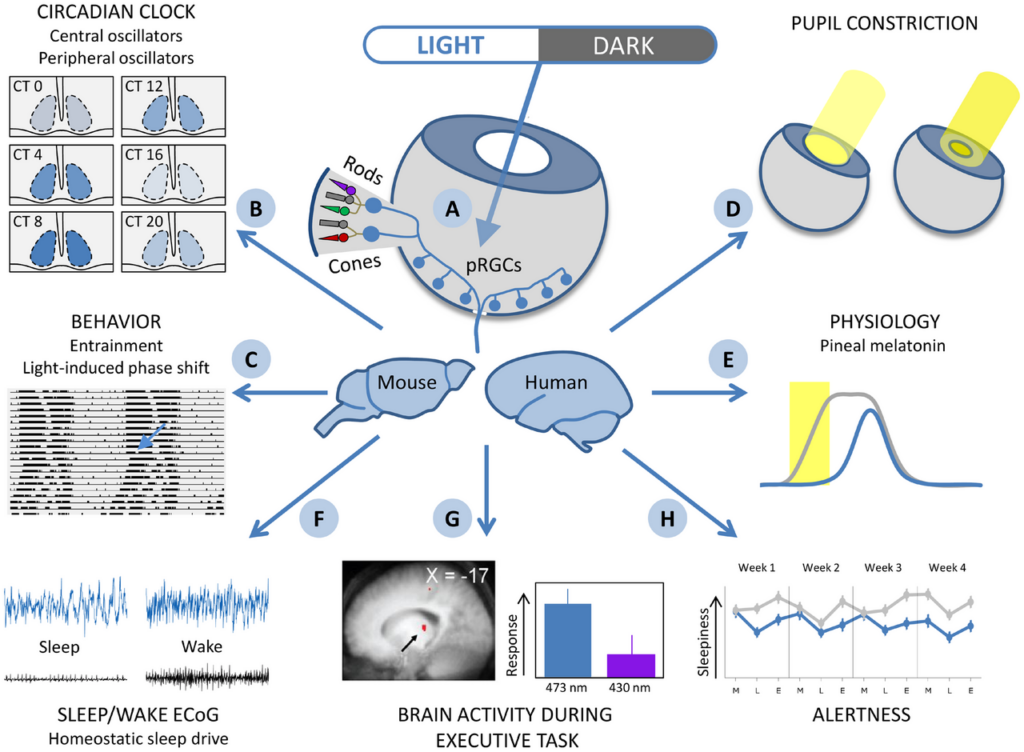
The effect of light on circadian rhythms in humans and mice. Source: Wikipedia
Thus, it was discovered that although circadian rhythms are generated by an “internal clock”, it is quite possible to adjust them. Further experiments have shown that their duration in humans can be artificially changed from 20 to 28 hours without any negative consequences.
The key to everything turned out to be lighting. The cells in our eyes constantly send biochemical signals to the suprachiasmatic nucleus, a part of the hypothalamus where PER protein is synthesised. If there is too much light in the evening, the synthesis of the protein is inhibited, while if there is a lot of light in the morning, its breakdown is accelerated. This is how the biochemical clock adjusts to real conditions.
At the same time, not only rods and cones responsible for vision send signals to the hypothalamus, but also special ganglion cells. Thanks to this, many even completely blind people can change their circadian rhythms.
What to do on the ISS?
Based on all this knowledge, it is worth considering the problem of sleeping on the ISS. Obviously, the idea of sleeping many times for 45 minutes during the day is completely unsuccessful. There should be one period of time when melatonin is produced. This hormone cannot switch on/off on command and quickly. Its presence in the body causes a decrease in cognitive skills, attention, and increased fatigue. All of this is not what astronauts need.
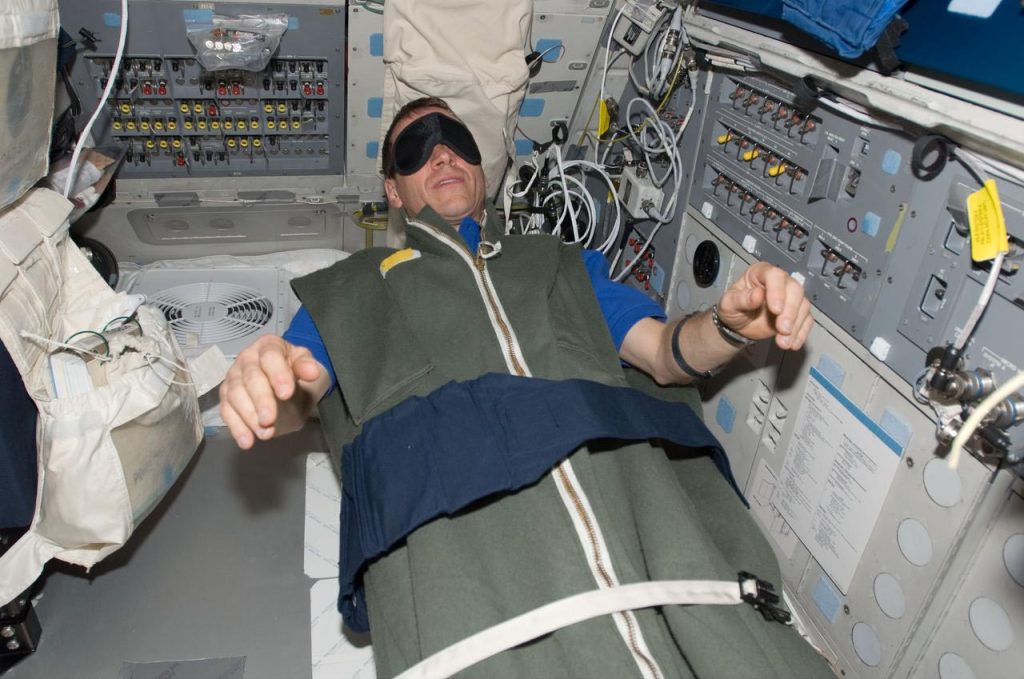
For the same reasons, the idea of sleeping whenever you want is also unsuccessful. For normal work, a person must have a clear daily routine. However, you can determine which part of the day can be defined as “night” in order to get enough sleep at that time.
In fact, there is no need to come up with something original. The ISS operates on universal time, which generally coincides with Greenwich Mean Time. So the hours that are considered nighttime in London are also nighttime at the station. To create the necessary conditions, the automation closes all the windows at this time, preventing sunlight from entering, and the lamps on the station itself are dimmed slightly, creating the illusion of dusk.
However, in reality, astronauts rely on all this rather little. In low-gravity conditions, the need for sleep usually decreases, so they can rest only 5-6 hours a day. Obviously, all this is agreed with the doctor who monitors their condition.
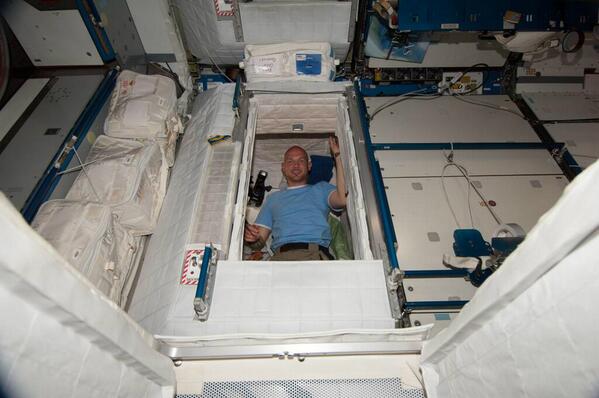
In general, sleep hours are determined separately for each astronaut. Each of them has their own specially designed sleeping bag. Its purpose is not to warm the person inside at all. The ISS maintains a constant temperature, but there is no gravity to “press” the body of a space traveller to any surface. And if an astronaut starts flying around the station’s compartments in a dream, he or she could get injured.
To prevent this, the sleeping bag is equipped with a system of straps. Using them, the astronaut can fix himself on a surface before going to sleep. It doesn’t matter which one, because in zero gravity, each of them can rightfully be considered either the floor or the ceiling.
During sleep, astronauts face another problem. They can only sleep with active ventilation. Otherwise, the absence of air movement leads to a carbon dioxide bubble forming around the head and a person can suffocate.
However, ventilation cannot work quietly — its sound sometimes reaches 65 dB. In such conditions, astronauts are forced to wear earplugs before going to bed. And, of course, not everyone is comfortable with reduced lighting: they need complete darkness to keep their circadian rhythms from being thrown off. Astronauts organise it for themselves in different ways. Some simply put on a light-proof blindfold, while others settle down to sleep in their own sleeping compartment the size of a small wardrobe. Not only does it provide the desired absence of light, but it also ensures privacy so that no one disturbs you while you rest.

